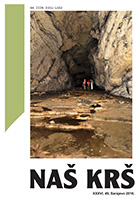TERMIČKE KARAKTERISTIKE SKADARSKOG JEZERA
THERMAL CHARACTERISTICS OF LAKE SKADAR
Author(s): Duško Vujačić, Goran Barović, Luka Mitrović, Jelena Golijanin, Golub ĆulafićSubject(s): Geography, Regional studies, Regional Geography, Environmental Geography
Published by: Centar za krš i speleologiju
Keywords: lakes; biodiversity; climatic factors; karst;
Summary/Abstract: The lakes are important natural systems, particularly when they are located in the karst areas.They greatly support the economy of a country, they are significant habitats important for biodiversity conservation and equally important for recreation, tourism and various other activities.They are often threatened by sediments and other pollutants from the catchment area,whose products are deposited in lakes. Over time, through the natural process of disappearance,the lakes become swampy lake systems and as the process continues, they get transformed into meadows and forests. In addition to human influence, which generally speeds up the process of “aging” of the lake, an increase in the temperature of the lake water is a catalyst for these processes.Temperature is an important factor to be taken into account when assessing the quality of water, as it may change the physical and chemical properties of water, especially in determining the metabolic rate of photosynthesis, toxicity, concentration of gases (oxygen and others); conductivity and salinity, oxidation reduction potential (ORP); pH; density of water.There are many factors that affect the temperature regime of the lake in general. Some authors emphasize the importance of dependence of lake water temperatures on the heat exchange with the atmosphere, as well as the physical mixing of the water column, on the basis of which we should expect that a slightest change in the temperature of the atmosphere may affect the water temperature.The authors of this paper remind us of a generally accepted fact that the water temperature changes continuously throughout the year, and that these changes are most pronounced in the areas where there is less water. Here it is important to analyse the geological structure of the substrate, hydrographical and geomorphological characteristics, then the specific climate parameters (air temperature, insolation, cloudiness, precipitation), and the influence of surface waters. This work also includes studies that highlight the interaction between climate change and temperature regime of Skadar Lake, where while performing simulations,hydrodynamic models are used that allow assessment of the impact of climate changes on the lake ecosystems. Attention has been paid to other factors, such as surface water inflow, lake -groundwater interaction, etc.Overall, all the analyses carried out in this paper are aimed at forming factors of regime of Skadar Lake, a sunken karst field and crypto-depression whose basin occupies an area of approximately 5490 km2. The area and volume of the lake are variable and depend directly on the water levels. The surface of the lake which belongs to Montenegro is larger than the part that belongs to Albania and is approximately 4460 km2 or 81.2%.
Journal: Naš krš
- Issue Year: XXXVI/2016
- Issue No: 49
- Page Range: 26-41
- Page Count: 16
- Language: Serbian

